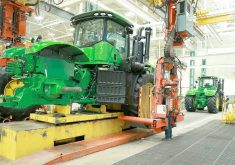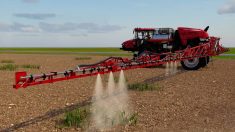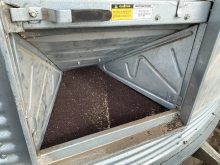Editor, Manitoba Co-operator
Over much of Saskatchewan it was common for farmers en route to town to become trapped in soil drifts across the roads in summer as by snowdrifts in winter. Men Against the Desert,
James H. Gray 1967
Few us can imagine much less remember the conditions that brought the Prairie Farm Rehabilitation Administration into being in 1935.
The Prairies had been settled by farmers unprepared for the harsh but fragile semi-arid ecosystem. Within a few decades, they had created an environmental catastrophe. Even in years of good rain, the soil was simply blowing away.
Read Also

Farm equipment sales sector sees significant structural changes
Farming equipment sales have been declining for a number of years now, and one industry professional believes structural changes in the industry are needed to curb that trend.
The former breadbasket of the world was dependent on handouts from the East to support the farm families who had not abandoned their homesteads. Livestock and horses were chronically undernourished. The risk of mass starvation was constant.
Even though researchers at the Dominion Experimental Farms had made progress developing techniques for controlling the erosion that was rapidly turning entire townships to unproductive wasteland, they lacked the capacity to deliver it to farmers. The budgetary, administrative and jurisdictional hurdles were cumbersome to the point of rendering them helpless.
And farmers, by that time, no longer had the resources to put the knowledge into action.
The situation was so critical that there was rare unanimity in the House of Commons for spending what seemed like extraordinary amounts of money during the Depression.
While the PFRA worked closely with the Dominion researchers and reported to the same federal minister, it had its own mandate and its own budget – a detail that would prove instrumental to its success in beating back the desert.
Somehow, largely through the passion and commitment of its field staff, it was able to cut through the red tape and get the job done.
According to Gray’s historical account, the PFRA staff, led by L. B. Thomson, conscripted their federal counterparts and hit the road, sleeping in cars if necessary, to help farmers create local Agricultural Improvement Associations, establish demonstration farms and distribute seed for the crested wheat grass and rye that could be used to hold the soil in place.
They were true civil servants – so much so that it created a certain degree of nervousness among the bureaucrats to whom they answered.
There’s a story about a Civil Service Commission investigator sent to the Prairies to find out why Dominion researchers had fallen behind in their paperwork. To his horror, he found them doing extension and education, which were supposed to be provincial jurisdiction.
When he complained, he was told to take it up with L. B. Thomson. He went back to Ottawa in frustration – and the Prairie rehabilitation work continued.
That independent streak was still present at the turn of the millennium when the PFRA authored the Prairie Agricultural Landscapes report – a document which openly questioned aggressive new export targets set by Agriculture and Agri-Food Canada and the industry.
The PAL report was a lone voice speaking for the environment. It noted increasing agricultural and agri-food exports to four per cent of the global agri-food trade by 2004 could compromise the sustainability of the Prairie landscape, which contains 83 per cent of Canada’s agricultural land base.
“The increase in production and processing of goods on the Canadian Prairies will pose numerous challenges for the sustainable management of the resource base,” the report said, noting upwards of 50 per cent of the land continues to be exposed to erosion, while salinity rates continue to rise and fertility levels continue to decline due to lost soil organic matter.
And the estimate that another million hectares of land would have to be brought under cultivation indicated a likelihood that most of those lands would be environmentally sensitive.
“It is generally accepted that the greater the level of agricultural intensity in an area, the greater the risk to groundwater and surface water quality. This is significant in light of the desire for expansion and intensification of agricultural production across the Prairies,” the PAL report warned.
This is worth remembering in the context of recent developments that have finalized the PFRA’s gradual absorption into a branch of AAFC.
On one hand, it’s hard to argue with the notion that its scope should be national. Hence, the name “prairie” no longer applies. Or that the “rehabilitation” of the lands at risk of becoming a desert has been accomplished, so the word is obsolete.
But we wonder whether the PAL report, with all its frankness, would have become a public document had the PFRA been operating under its current administration. Likewise, we wonder whether its historic ability to cross bureaucratic and jurisdictional boundaries to get the job done will continue.
We can’t help but fear that more than a name has been lost. [email protected]















